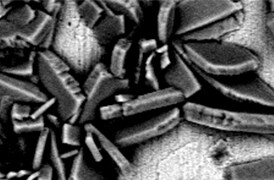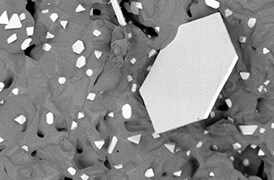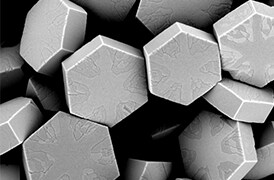Search Thermo Fisher Scientific

Materials Science
DualBeam FIB Cross Sectioning
FIB cross section generation with DualBeam tools for automated and high throughput subsurface characterization.
Join the conversation

performed on a Helios G4 PFIB DualBeam.
Modern materials characterization is increasingly reliant on sub-surface characterization for a more comprehensive understanding of the material’s structure and physical properties. Cross-sectioning with a DualBeam instrument, which combines a focused ion beam with a scanning electron microscope (FIB-SEM), allows you to mill the material with FIB and perform high-resolution SEM imaging at nanometer scale. In failure analysis, for instance, this allows for defects to be located under the surface, making DualBeams instruments ideal for identification of the root cause of failures.
Along with high-resolution SEM imaging, cross-section characterization on the DualBeam can be expanded with back-scattered electron (BSE) imaging for maximum materials contrast, energy-dispersive X-ray spectroscopy (EDS) for compositional information, and electron backscatter diffraction (EBSD) for microstructural and crystallographic information.
Additionally, with the introduction of the Thermo Scientific Helios 5 Hydra DualBeam, we now offer the flexibility of argon, oxygen, xenon, and nitrogen ion species in one instrument, allowing you to choose the best FIB type for each of your experiments. Xenon ions are well suited for high-throughput removal of various materials, like metals and ceramics, whereas oxygen ions provide superior milling quality for carbon-based samples. In case extremely large volume characterization is needed, the Thermo Scientific Helios 5 Laser PFIB System is an additional solution. It enables high-throughput cross-sectioning up to millimeter scale, as well as processing of materials that are typically challenging for ion beams (e.g. charging or beam sensitive samples). We combine these unique DualBeam capabilities with our versatile software solutions to bring you a range of workflows for advanced 3D characterization and high-resolution analysis at the nanometer scale.

Process control using electron microscopy
Modern industry demands high throughput with superior quality, a balance that is maintained through robust process control. SEM and TEM tools with dedicated automation software provide rapid, multi-scale information for process monitoring and improvement.

Quality control and failure analysis
Quality control and assurance are essential in modern industry. We offer a range of EM and spectroscopy tools for multi-scale and multi-modal analysis of defects, allowing you to make reliable and informed decisions for process control and improvement.

Fundamental Materials Research
Novel materials are investigated at increasingly smaller scales for maximum control of their physical and chemical properties. Electron microscopy provides researchers with key insight into a wide variety of material characteristics at the micro- to nano-scale.

Battery Research
Battery development is enabled by multi-scale analysis with microCT, SEM and TEM, Raman spectroscopy, XPS, and digital 3D visualization and analysis. Learn how this approach provides the structural and chemical information needed to build better batteries.

Oil and Gas
As the demand for oil and gas continues, there is an ongoing need for efficient and effective extraction of hydrocarbons. Thermo Fisher Scientific offers a range of microscopy and spectroscopy solutions for a variety of petroleum science applications.

Metals Research
Effective production of metals requires precise control of inclusions and precipitates. Our automated tools can perform a variety of tasks critical for metal analysis including; nanoparticle counting, EDS chemical analysis and TEM sample preparation.

Catalysis Research
Catalysts are critical for a majority of modern industrial processes. Their efficiency depends on the microscopic composition and morphology of the catalytic particles; EM with EDS is ideally suited for studying these properties.

Polymers Research
Polymer microstructure dictates the material’s bulk characteristics and performance. Electron microscopy enables comprehensive microscale analysis of polymer morphology and composition for R&D and quality control applications.

Geological Research
Geoscience relies on consistent and accurate multi-scale observation of features within rock samples. SEM-EDS, combined with automation software, enables direct, large-scale analysis of texture and mineral composition for petrology and mineralogy research.
Electron microscopy services for
the materials science
To ensure optimal system performance, we provide you access to a world-class network of field service experts, technical support, and certified spare parts.











